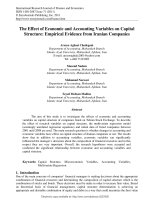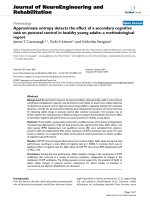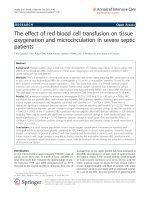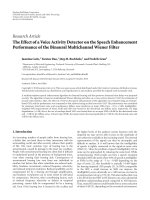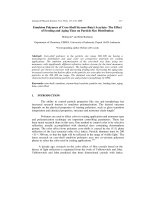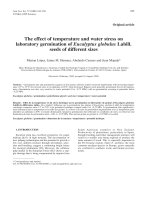The effect of high intensity focused ultrasound on enterococcus faecalis biofilm
Bạn đang xem bản rút gọn của tài liệu. Xem và tải ngay bản đầy đủ của tài liệu tại đây (3.34 MB, 140 trang )
THE EFFECT OF HIGH INTENSITY FOCUSED ULTRASOUND ON
ENTEROCOCCUS FAECALIS BIOFILM.
KULSUM IQBAL
(BDS)
A THESIS SUBMITTED
FOR THE DEGREE OF MASTER OF SCIENCE
DISCIPLINE OF PROSTHODONTICS, OPERATIVE DENTISTRY AND
ENDODONTICS
FACULTY OF DENTISTRY
NATIONAL UNIVERSITY OF SINGAPORE
2013
Supervisor: A/P Jennifer Neo
Co-Supervisor: Dr Amr Fawzy
i
DECLARATION
I hereby declare that the thesis is my original work and it has been written by me in its entirety. I have
duly acknowledged all the sources of information which have been used in the thesis. This thesis has
also not been submitted for any degree in any university previously.
_________________
Kulsum Iqbal
3 August 2013
ii
Acknowledgements
With great pleasure in the completion of my project I would like to express my gratitude to all those
who provided their kind support and motivation.
First and foremost I would like to thank my supervisors, Prof. Jennifer Neo and Dr.Amr for giving me
an opportunity to join as a graduate student at this esteemed university. Their leadership, support,
motivation and continuous hard work have inspired me a lot. I deeply appreciate Dr. Amr for his
contributions, help and uncountable hours spent in guiding me throughout my project. It has been a
great odyssey with which I would cherish a lifetime. I would like to express my gratitude to Dr Tan
Kai Soo for her invaluable support in allowing me to perform my experiments in her lab.
Furthermore, I would like to thank Prof Khoo and Siew Wan for sharing their transducer for my
project. They have been helping and guiding me in carrying out my research which would not have
been possible without their continuous support.
I would like to specially thank Mr Chan for his technical support always and Aunty Leena and Ms
Han for providing a comfortable working environment. The sincere help from my lab members helped
me a lot in working as a team.
I would like to pay my sincere appreciation to my husband and my family who provided me support
and encouragement.
Finally I would like to thank the Faculty of Dentistry for its support throughout my whole Master’s
program.
Kulsum Iqbal
iii
Table of Contents
1
Chapter I – Introduction .................................................................................................................. 1
2
Chapter II – Literature Review ....................................................................................................... 8
2.1
Basic Concepts of Ultrasound Physics.................................................................................... 8
2.2
Properties of Ultrasound Waves ........................................................................................... 10
2.2.1
Wavelength ................................................................................................................... 10
2.2.2
Frequency ...................................................................................................................... 11
2.2.3
Ultrasound Speed .......................................................................................................... 11
2.2.4
Medium Density and Compressibility .......................................................................... 11
2.2.5
Absorption..................................................................................................................... 12
2.2.6
Intensity......................................................................................................................... 12
2.2.7
Power ............................................................................................................................ 13
2.3
History of Ultrasound in Medicine ....................................................................................... 14
2.3.1
Therapeutic Ultrasound ................................................................................................. 17
2.3.2
High Intensity Focused Ultrasound (HIFU) .................................................................. 20
2.3.2.1
Historical Background .............................................................................................. 21
2.3.2.2
Principle of HIFU...................................................................................................... 22
2.3.2.3
Thermal effects of HIFU ........................................................................................... 24
2.3.2.4
Non thermal effects ................................................................................................... 25
iv
2.3.2.5
Stable cavitation ........................................................................................................ 26
2.3.2.6
Inertial Cavitation ..................................................................................................... 27
2.3.2.7
Radiation force .......................................................................................................... 27
2.3.3
Current Clinical Applications of HIFU ......................................................................... 28
2.3.3.1
Liver tumors .............................................................................................................. 28
2.3.3.2
Renal tumors ............................................................................................................. 29
2.3.3.3
Prostate cancer .......................................................................................................... 30
2.3.3.4
Gynecology ............................................................................................................... 31
2.3.3.4.1
Uterine fibroids ................................................................................................... 31
2.3.3.5
Neurosurgical...................................................................................................... 31
2.3.3.5.1
Targeted Drug Delivery: ..................................................................................... 32
2.3.3.5.2
Enhancement of drug delivery ............................................................................ 32
2.3.4
HIFU application in dentistry ....................................................................................... 33
2.3.4.1
Role of biofilms in infections.................................................................................... 34
2.3.4.2
Biofilms in endodontics ............................................................................................ 35
2.3.4.3
Techniques in root canal disinfection ....................................................................... 36
2.3.4.3.1
Mechanical debridement ..................................................................................... 36
2.3.4.3.2
Chemical disinfection ......................................................................................... 37
2.3.4.3.2.1
Sodium hypochlorite .................................................................................... 37
2.3.4.3.2.2
Chlorhexidine digluconate ........................................................................... 38
2.3.4.3.2.3
Ethylenediaminetetraacetic acid (EDTA) .................................................... 38
2.3.4.3.3
Agitation of the irrigants..................................................................................... 39
v
3
2.3.4.3.3.1
Manual agitation techniques ........................................................................ 39
2.3.4.3.3.2
Machine assisted irrigation .......................................................................... 40
Chapter III: Hypotheses and Objectives ....................................................................................... 43
3.1
Hypotheses: ........................................................................................................................... 43
3.2
Objectives ............................................................................................................................. 43
3.2.1
Phase 1: To study the effect of HIFU on E. faecalis planktonic suspensions. .............. 43
3.2.2
Phase 2: To study the effect of HIFU on E. faecalis biofilms on glass-bottom petri dish.
……………………………………………………………………………………………….43
3.2.3
Phase 3: To study the effect of HIFU on E. faecalis biofilm on root dentin –disc and
whole root dentin surface. ............................................................................................................. 44
3.2.4
4
Phase 4: To study the effect of irrigants on HIFU efficacy. ......................................... 44
Chapter IV- Methods and Materials.............................................................................................. 46
4.1
Experimental set up............................................................................................................... 46
4.1.1
Water tank ..................................................................................................................... 47
4.1.2
Driving circuit ............................................................................................................... 48
4.1.3
Waveform function generator ....................................................................................... 48
4.1.4
Amplifier ....................................................................................................................... 48
4.1.5
Transducer..................................................................................................................... 49
4.1.6
Hydrophone................................................................................................................... 50
vi
4.2
Measurement of temperature changes................................................................................... 51
4.3
Inoculation of E. faecalis ...................................................................................................... 51
4.3.1
Phase 1: HIFU exposure on planktonic suspensions..................................................... 52
4.4
Biofilm formation ................................................................................................................. 53
4.5
Specimen preparation............................................................................................................ 53
4.5.1
Root discs ...................................................................................................................... 53
4.5.2
Root canal dentin .......................................................................................................... 54
4.5.3
Root disc and root canal contamination ........................................................................ 55
4.6
Phase 2: HIFU exposure on biofilms -Petri dish.................................................................. 56
4.7
Phase 3: HIFU Exposure on biofilms- Dentin Disc and Root Canal Dentin ........................ 57
4.7.1
Dentin Disc ................................................................................................................... 57
4.7.2
Root canal Dentin.......................................................................................................... 58
4.8
Phase 4: HIFU Exposure on biofilms- Root canal Dentin with Irrigants.............................. 59
4.8.1
Root canal Irrigants used: EDTA and sodium hypochlorite (NaOCl). ......................... 59
4.8.2
Classification of the Groups .......................................................................................... 59
4.8.2.1
Control group (no HIFU): ......................................................................................... 59
4.8.2.2
Conventional syringe irrigation group with NaOCl: ................................................. 60
4.8.2.3
Conventional syringe irrigation group with EDTA: ................................................. 60
4.8.2.4
“HIFU NaOCl”: ........................................................................................................ 60
vii
4.8.2.5
“HIFU EDTA”: ......................................................................................................... 60
4.8.2.6
Harvesting the Biofilm .............................................................................................. 60
4.8.2.6.1
5
Microbiological analysis for petri dish and root dentin biofilm. ........................ 60
4.9
Scanning electron microscopy (SEM). ................................................................................. 61
4.10
Confocal laser scanning microscopy (CLSM) ...................................................................... 62
4.11
Statistical analysis ................................................................................................................. 63
Chapter V: Results ........................................................................................................................ 65
5.1
Temperature variation ........................................................................................................... 65
5.2
Phase 1: The effect of HIFU on E. faecalis planktonic suspensions..................................... 66
5.3
Phase 2: The effect of HIFU on E. faecalis biofilms on glass-bottom petri dish.................. 67
5.4
Phase 3: The effect of HIFU on E. faecalis biofilm on root dentin disc and root dentin
surface ………………………………………………………………………………………………71
5.4.1
Root dentin disc ............................................................................................................ 71
5.4.2
Root canal dentin surface .............................................................................................. 74
5.5
Phase 4: The effect of different irrigants along with HIFU. ................................................ 76
6
Chapter VI: Discussion ................................................................................................................. 79
7
Chapter VII: Conclusions.............................................................................................................. 89
8
Chapter VIII: Future perspectives ................................................................................................. 91
9
Chapter IX: Bibliography.............................................................................................................. 93
viii
Summery
The foremost aim of endodontic treatment is the complete removal of micro-organisms, their byproducts and pulpal tissue remnants. Currently, chemo-mechanical preparation (chemical irrigant
combined with mechanical instrumentation) of the root canal system is in use. Bacteria are naturally
present in oral milieu as biofilm which is known to be a survival mechanism of bacteria. Previous
literatures have shown that conventional endodontic disinfection techniques are not able to disinfect
the root canal completely. Therefore, the limitations of the conventional root canal disinfection
procedures demand the need of alternative disinfection strategies. In this study, High Intensity
Focused Ultrasound (HIFU) was used as one of these potential methods. To verify our hypothesis, the
effect of HIFU on planktonic suspensions and biofilm of Enterococcus faecalis (E. faecalis) on
different substrates were analysed.
The main aims of this study were to examine the potential of HIFU as an alternative and efficient
method for root canal disinfection. To achieve our aims, sequential phase wise studies were
conducted. The objective of Phase 1 was to study the effect of HIFU on E. faecalis planktonic
suspensions. The results indicated that a bactericidal effect of HIFU was time dependent i.e. a
significant reduction in Colony forming units (P ≤ 0.05) was found with increasing HIFU exposure.
Phase 2 was carried out to study the effect of HIFU on two-week old E. faecalis biofilms on glassbottom petri dish at different time periods of 30, 60, 120 s. The results from these experiments
showed significant increase in CFU after HIFU exposure for 30 s compared to the control group (P ≤
0.001). At 60 s exposure to HIFU, the CFU was significantly higher than the control group (P ≤ 0.05).
Furthermore, a significant reduction in biofilm thickness was found with increased exposure time of
HIFU.
ix
In Phase 3, the effect of HIFU was observed on biofilm attached to root dentin disc and whole root
canal dentin. The results were analysed by CFU, SEM and CLSM. From 30 s exposure, the biofilm
removal effect of the HIFU can be clearly seen when compared to the control. However, 120 s
exposure showed to be the most effective in the removal of biofilm. Significant increase (P ≤ 0.05) in
CFU was found till 30 s exposure to HIFU in comparison to the control group. However, at 60 and
120 s, the CFU values were significantly decreased compared to the 30 s exposure. In addition, there
was a significant reduction (P ≤ 0.05) in the biofilm thickness with the increase in the exposure time
to HIFU. In Phase 4, experiments were performed using different irrigants which are widely used in
endodontics for disinfection of root canal system in adjunct with HIFU. We found “HIFU + NaOCl”
group to be significantly effective in terms of biofilm removal and killing of E. faecalis biofilms
compared to the control (P ≤ 0.05).
In summary, this study highlighted the potential application of HIFU as a novel method for
root canal disinfection for the potential for clinical application.
x
List of Tables
Table 1: The development of ultrasound technology throughout the century ...................................... 14
xi
.List
of Figures
Figure 1: Concept of molecular motion. Oscillation of air molecules produced by a speaker. .............. 8
Figure 2: Frequency bands for acoustic range. Humans hear frequency from 20 to 20,000 cycles/sec.
Ultrasound is above 20 kHz and infrasound is below 20Hz. .................................................................. 9
Figure 3: The temporal and length characteristics of an ultrasound wave. ........................................... 10
Figure 4: (a) Diagram shows properties of a geometrically focused transducer. (b) Picture depicts a
cigar shaped lesion from a HIFU wave generated by a MHz transducer. ............................................ 23
Figure 5: Thermal effect of HIFU. The focal point is cigar shaped known as the biological focal
region. ................................................................................................................................................... 24
Figure 6: Mechanical effect of HIFU. ................................................................................................... 25
Figure 7: Cavitation effect of HIFU. ..................................................................................................... 26
Figure 8: Stages of biofilm formation. .................................................................................................. 34
Figure 9: The experimental set up for HIFU. ........................................................................................ 46
Figure 10: Waveform generator (top) and Amplifier (bottom) used in this study. .............................. 48
Figure 11: Piezoelectric bowl shaped transducer. ................................................................................. 49
Figure 12: (a) Hydrophone (red) is used to measure the pressure at the focal point of the generated
wave with the help of oscilloscope (b).................................................................................................. 50
Figure 13: Pictorial representation of the petri dish exposed to HIFU waves (cylindrical shape)
generated from the transducer. .............................................................................................................. 52
xii
Figure 14: Root dentin specimens coated with nail varnish (pink) and attached to the Eppendorf tube
with impression material. ...................................................................................................................... 55
Figure 15: Pictorial representation of HIFU set up (A) for exposure to root dentin discs (B) placed in
glass test tube. ....................................................................................................................................... 57
Figure 16: Root dentin with biofilm attached to Eppendorf using rubber-base impression material. . 58
Figure 17: The variation in temperature rise from room temperature of water with increasing time of
HIFU exposure. ..................................................................................................................................... 65
Figure 18: Means and standard deviation of the surviving log number of bacteria (CFU) after different
HIFU exposure times to planktonic suspensions of E. faecalis. ........................................................... 66
Figure 19: Means and standard deviation of the surviving log number of bacteria (CFU) after different
HIFU exposure times to biofilms of E. faecalis.................................................................................... 67
Figure 20: Three dimensional CSLM images showing structure of biofilms exposed to different HIFU
exposure times. ..................................................................................................................................... 68
Figure 21: Selected SEM images of different time HIFU exposure on glass-bottom petri dish. .......... 69
Figure 22: Variation in biofilm thickness observed over different HIFU exposure times. .................. 70
Figure 23: Selected SEM (2000X) and confocal images (60X) of HIFU exposed root dentin disc
specimens. ............................................................................................................................................. 72
Figure 24: Analysis of the effect of different time HIFU exposure on biofilm. ................................... 73
Figure 25: Selected SEM images of root dentinal surface wall of HIFU exposed specimens. ............. 75
Figure 26: Colony forming units of surviving bacteria collected from water after different time points
of 30, 60 and 120 s HIFU exposure. ..................................................................................................... 76
xiii
Figure 27: Means and standard deviation of the surviving log number of bacteria (CFU) collected
after different HIFU exposure times on E. faecalis. Selected SEM images of root dentin specimens
after treated with either conventional irrigation or exposed to HIFU for 120 s with NaOCl or EDTA.
.............................................................................................................................................................. 77
xiv
List of Abbreviations
Enterococcus faecalis (E. faecalis)
High intensity focused ultrasound (HIFU)
Benign prostate hyperplasia (BPH)
Brain Heart Infusion (BHI)
Colony forming units (CFU)
Confocal laser scanning microscopy (CLSM)
Ethylene diamine tetra acetic acid (EDTA)
Hepatocellular carcinoma (HCC)
Scanning electron microscopy (SEM)
Sodium hypochlorite (NaOCl)
Working length (WL)
xv
List of Publications
Journal publications:
1. “Effect of High Intensity Focused Ultrasound on Enterococcus faecalis planktonic
suspensions and biofilms”. Kulsum Iqbal, Siew-Wan Ohl, Boo-Cheong Khoo, Jennifer Neo,
Amr S. Fawzy, Ultrasound in Medicine and Biology, 2013 May,39(5):825-33.
Conferences:
1. “Minimal invasive technique for the removal of biofilm by HIFU”. Kulsum Iqbal, Siew-Wan
Ohl, Khoo Boo Cheong, Amr Fawzy, Jennifer Neo. IADR Australia and New Zealand
Division, Sep 2011.
2. “Potential of HIFU on removal and reduction of Enterococcus faecalis biofilms”. Kulsum
Iqbal, Siew-Wan Ohl, Khoo Boo Cheong, Amr Fawzy, Jennifer Neo. IADR/LAR General
Session, Brazil June 2012.
xvi
Introduction
Chapter I
Introduction
1
Introduction
1
Chapter I – Introduction
From the early discovery of oral bacteria in the late 1600’s (Bibel, 1983), the knowledge of oral and
odontogenic disease has increased tremendously. In early 1894, Miller discovered that bacteria could
infect and persist in the pulpal tissues causing pulpal alterations (Miller, 1894). Although this study
reformed the way we looked at bacterial contribution in the pulpal symptoms and pulpal changes, it
was ambiguous until 1960’s that bacteria was actually found to be related to endodontic pathology.
The classical study by Kakehashi et al.(1965) was the first to demonstrate the existence of bacteria in
the pulpal tissues leading to pulpal pathology and periapical breakdown. In this study, the group
showed this finding involving a group of germ-free rats that had pulpal exposure; and a second group
of rats with normal oral bacteria flora but similar pulpal exposure. The germ-present rats developed
pulpal necrosis and periapical periodontitis when compared to germ-free rats which showed no signs
of pulpal pathology or insult. This led to a more scientific based understanding of endodontics. It has
been reported that more than 700 bacterial species are residents of the human oral cavity (Paster and
Dewhirst, 2000). It is a common knowledge that dental caries is the primary condition which is
caused mainly by bacteria and this is one of the most common routes whereby bacteria enter the pulp
from the oral cavity. These microbes once inside the tooth reside within the dentinal tubules and
contaminate dental pulp which results in pulpal infection. The lack of an efficient collateral
circulation within the pulp, results in a failure of the body to clear the infection or to benefit from the
immune mechanisms of the body. The root canal system provides a condusive environment for
microbes and toxins followed by healing impairment leading to primary root canal infection.
Primary root canal infection is defined as infectious disease caused by microorganisms colonizing the
root canal system (Kakehashi et al., 1965; Moller et al., 1981; Sundqvist, 1976). Primary endodontic
infections are polymicrobial in nature. Microorganisms most frequently found are gram- negative
anaerobic rods, gram-positive anaerobic cocci, gram positive anaerobic, facultative rods,
Lactobacillus and Streptococcus species (Sundqvist, 1994). Root canal treatment is the conventional
treatment of primary root canal infection (Haapasalo, 2005) which aims to eliminate the infection
1
Introduction
from the root canal and prevent reinfection (Sjögren, 1990). However, it has been shown that after
root canal treatment, persistent infection can lead to root canal failure with secondary root canal
infection (Pinheiro et al., 2003; Sundqvist et al., 1998). Secondary root canal infection occurs due to
viable bacteria harbouring within the root canal system which includes the dentinal tubules, accessory
canals, isthmuses (Buck et al., 2001; Nair et al., 2005; Safavi et al., 1990).
One of the resistant microbes found in secondary root canal infection is Enterococcus faecalis (E.
faecalis), which is a gram positive coccus (de Paz, 2007; Murray, 1992) existing as a normal
commensal of the intestine and has been reported with a low prevalence in primary endodontic
infections. However, studies have shown its prevalence ranging from 24% to 77% in secondary
infections (Hancock et al., 2001; Stuart et al., 2006). The pathogenicity of E. faecalis is due to its
ability to adapt to the varying environment, inherent antimicrobial resistance and capability to form
biofilm on root canal surfaces (Duggan and Sedgley, 2007; Lin et al., 1992).
Biofilms are microbial communities encased by extracellular polysaccharides (EPS) produced by
these microbial cells, which adhere to the interface of a liquid or a solid surface (Costerton and Keller,
2007). These are present in necrotic pulp canal spaces of primary and secondary infections (Ricucci
and Siqueira, 2010). Bacteria in a biofilm are different in phenotype and more resistant to
antimicrobials than their corresponding planktonic state (Ceri et al., 1999; Costerton, 1999; Gilbert et
al., 1997; Millward and Wilson, 1989). The aim of root canal treatment is to render the root canal
system bacteria free which is a challenging task owing to the complicated anatomy of the root canal
system. Additionally, conventional techniques of root canal disinfection using mechanical
instrumentation with the usage of hand and rotary instruments (Bystrom and Sundqvist, 1981) have
shown to reduce bacteria within the root canal system. However, significant portions of root canal
wall may not be thoroughly debrided during instrumentation, (Peters et al., 2001; Wu et al., 2003b)
leaving behind viable bacteria. Similarly, Ørstavik et al. also reported inadequate antibacterial
efficiency of mechanical preparation (Orstavik et al., 1991).
2
Introduction
One of the options was the use of chemico-mechanical instrumentation whilst it was shown to reduce
the bacterial load, complete disinfection was challenging (Bystrom et al., 1985). Additionally, several
studies stated the presence of remaining microbes even after instrumentation and irrigation with 25%
(Vianna et al., 2006), 20% (Bystrom and Sundqvist, 1983), and 65 % (Kvist et al., 2004) of sodium
hypochlorite (NaOCl). NaOCl is the most widely used endodontic irrigating solution. However, the
main limitations of conventional techniques could be attributed to the inability of chemical
disinfectants to destroy bacteria present in the inaccessible regions of the root canal system. In
addition, biofilms in the root canal system was highly resistant to antimicrobials due to their
inefficient ability to physically disrupt them (Costerton et al., 1994; Nair et al., 2005; Parsek and
Singh, 2003).
NaOCl was first introduced as an antiseptic by Dakin in 1915 and was used in 0.5% concentration
(pH of 9). As an endodontic irrigant, NaOCl has been shown to possess potent antimicrobial action in
concentrations ranging from 5.25% to 0.5% (Bystrom and Sundqvist, 1985a; Haapasalo et al., 2000;
Portenier et al., 2001). The antibacterial effect of NaOCl is attributed to HOCl, hypochlorous acid.
This acid disrupts oxidative phosphorylation and DNA synthesis in bacteria but the canal must have a
pH of 4-7 for the acidic form to be present. Furthermore, it has excellent tissue dissolving properties
(Beltz et al., 2003; Koskinen et al., 1980; Senia et al., 1971). However, NaOCl is highly cytotoxic and
can be very damaging to vital tissue in endodontic treatment if extruded into the periapical tissues.
Studies have shown the adverse effects of NaOCl on dentin on mechanical properties (Sim et al.,
2001). Consequently, researchers and clinicians have investigated other irrigants like Ethylene
Diamine Tetraacetic (EDTA) and chlorhexidine (CHX).
EDTA is widely used in endodontics. It is a chelating agent used to remove the smear layer produced
during mechanical preparation (Prado et al., 2011; Zehnder, 2006). Additionally, it has antimicrobial
effects that may be suitable for clinical use (Siqueira et al., 1998). Interestingly, the main benefit of
EDTA over NaOCl is its action on the smear layer. EDTA has been shown to be effective in removing
3
Introduction
the smear layer by chelating the inorganic component of the dentin (Goldberg and Abramovich, 1977;
McComb and Smith, 1975). A previous clinical study investigated the effect of irrigation using EDTA
with saline and EDTA alone demonstrated no bacteria in canals that were irrigated with EDTA. The
authors concluded that saline only removed superficial bacteria while EDTA helped in removal of
smear layer and bacteria (Yoshida et al., 1995).
Similar to EDTA, chlorhexidine is another widely used irrigant. It has extensive antimicrobial
spectrum and is effective against gram negative and gram positive bacteria in addition to yeast
(Davies and Hull, 1973; Emilson, 1977). Despite its relatively low cytotoxicity (Yesilsoy et al., 1995)
its activity is pH dependent and decrease in the presence of organic matter (Russell and Day, 1993) as
well as it lacks the tissue dissolving ability of NaOCl. In addition to root canal irrigants, intracanal
medicaments such as calcium hydroxide have been proposed for endodontic treatment. Calcium
hydroxide has low solubility in water and its high pH prevents growth and survival of bacteria.
However, studies have shown that calcium hydroxide may not be an ideal intracanal medicament as
bacteria have shown to endure an alkaline pH. Till today, Law and Messer is of the view that an ideal
intra canal medicament has yet to be found. They proposed that chemical disinfection was still needed
to be used in conjunction with mechanical techniques (e.g. ultrasound) for more predictable outcomes.
The concept of the use of ultrasound in dentistry was initially introduced for cavity preparations
(Balamuth, 1967; Catuna, 1953; Postle and Robinson, 1958). Much as it was a great concept for
minimal invasive dentistry, it was not popular until 1955, when Zinner et al.(1955) used ultrasonics
to remove calculus deposits from tooth surfaces. This idea was further improved by Johnson and
Wilson (1957) who established the ultrasonic scalar for the removal of dental calculus and plaque and
was mainly used for scaling and root smoothening (Stock, 1991; Walmsley et al., 1992). In 1957
Richman introduced ultrasonics to endodontics for irrigation purposes. Additionally, Martin et al.
(1980) demonstrated the capability of ultrasonically activated K files to prepare root canals before
obturation. Martin and Cunningham coined the word ‘endosonic’ which authors defined as ‘the
4
Introduction
ultrasonic synergistic system of instrumentation and canal disinfection’ (Martin and Cunningham,
1984; 1985). This technology has been adapted in endodontics for access refinement, removal of
attached pulp stones, finding calcified canals and removal of intracanal obstructions, enhanced action
of irrigant, root canal preparation and surgical endodontics. Current researchers also included the use
of ultrasound in the removal of oral biofilm (Parini and Pitt, 2006; van der Sluis et al., 2007) and
dentin repair by the stimulation of odontoblasts and vascular endothelial growth factors (Scheven et
al., 2007). The use of ultrasound, when compared to syringe irrigation, produced enhanced results in
cleaning (Teplitsky et al., 1987) but still did not eradicate the bacteria from the root canal system
(Sequeira et al., 2007).
The pursuit to completely eliminate bacteria from the root canal system continues with some new
treatment modalities such as photodynamic therapy (Lee et al., 2004; Soukos et al., 2006) and laser
irradiation (Moshonov et al., 1995; Zhu et al., 2009). Concurrently, there is a continuous need to
improve existing strategies for disinfection or to devise other new methods for disinfection. We are
proposing the use of High Intensity Focused Ultrasound (HIFU) as a potential strategy for
disinfection.
HIFU has been widely used in medical applications such as removal of uterine fibroids (Chan AH,
2002; Chapman A, 2007), prostate cancer surgery (Madersbacher et al., 1995; Poissonnier et al.,
2007) and atrial fibrillation treatment (Ninet et al., 2005). It has also been explored in dentistry for
delivery of antibacterial nanoparticles (Shrestha et al., 2009). HIFU is generated using a focused
transducer which gives high intensity at its focal point with minimal damage to the surrounding
tissues. The fundamental principle behind is the formation of cavitation bubbles (Leighton, 1994a)
(Lea et al., 2005). These bubbles are in a non-equilibrium state and will oscillate and collapse
releasing energy. Intense ultrasound waves from HIFU create oscillating cavitations. These bubbles
which collapse with high-speed jets towards the adjacent surfaces (Lew et al., 2007) can be utilized
for various purposes such as biofilm removal. However, HIFU has not been studied in relation to
biofilm removal. The potential of HIFU in endodontics for removal of biofilms is worthy of further
5
Introduction
investigation as it can lead to an important step towards its clinical application in the field of
endodontics.
6
Literature Review
Chapter II
Literature Review
7
Literature Review
2 Chapter II – Literature Review
Ultrasonics is defined as the science of acoustics and technology of sound. In 600 BC a Greek
philosopher named Pythagoras set the stepping stone for the usage of stringed devices, which are
considered as remarkable contributions to the field of acoustics. Later, Galileo continued the work on
the new studies in this area. He demonstrated that pitch is related to vibration, which was thought to
be the next milestone in the field of acoustics. In today’s world, rapid development in computer
techniques has unlocked new possibilities for using ultrasonics for industrial as well as laboratory
purposes. Ultrasonic application has found its use in various fields such as medicine, dentistry, food
and textile industry and engineering. It is important to understand the basic elements and history of
ultrasonics.
2.1 Basic Concepts of Ultrasound Physics
Sound is defined as mechanical energy, which is transmitted by pressure waves through a medium,
(Fig 1). Cyclic changes in the pressure of the medium are produced by forces acting on the particles,
which cause them to oscillate around their normal positions. The term cycle is used to explain any
sequence of variations in molecular motion that recurs at fixed intervals, since the motion of the
particles is repetitive (Hedrick et al., 2005).
Figure 1: Concept of molecular motion. Oscillation of air molecules produced by a speaker.
(Adapted from “Effect of high intensity focused ultrasound on neural compound action potential : an in vitro study" (2011).
/>
8

